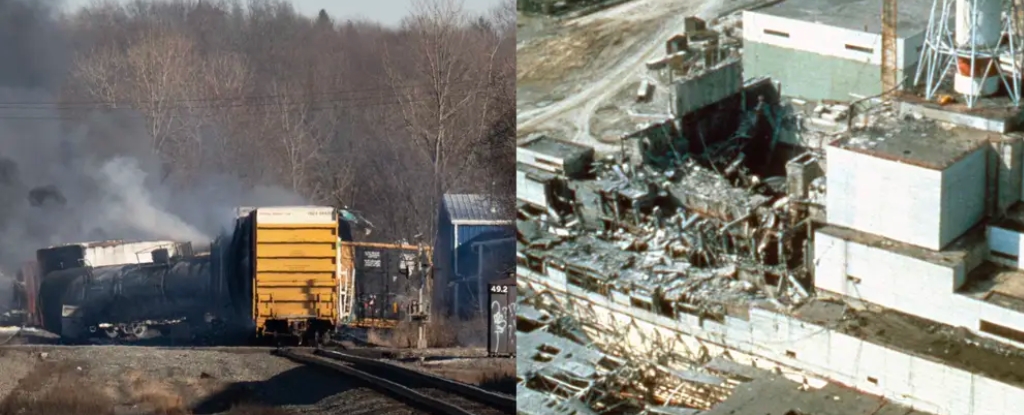Ohio Train Disaster: The Lingering Threat Of Toxic Chemicals In Buildings

Table of Contents
Pathways of Chemical Contamination in Buildings
The toxic chemicals released during the Ohio train derailment can infiltrate buildings through various pathways, posing a significant threat to human health. Understanding these pathways is crucial for effective remediation efforts.
Air Ingress
Volatile organic compounds (VOCs), such as vinyl chloride and butyl acrylate, are readily dispersed through the air. These chemicals can infiltrate buildings through several routes:
- Ventilation systems: HVAC systems can inadvertently draw contaminated air directly into buildings, distributing the toxins throughout.
- Cracks and gaps: Even seemingly minor cracks in walls, windows, and foundations can allow contaminated air to seep inside.
- Open windows and doors: In the immediate aftermath of the derailment, and even in the following days and weeks, open windows and doors provided direct pathways for contaminated air to enter homes and businesses.
- Porous building materials: Many building materials, such as wood and drywall, are porous and can absorb VOCs from the surrounding air, slowly releasing them into indoor spaces over time.
The long-term effects of indoor air pollution from these chemicals are significant and can include respiratory problems, headaches, and other health complications. Weather patterns, such as wind direction and precipitation, play a crucial role in the dissemination of these chemicals and, consequently, the level of contamination in buildings.
Surface Deposition
Less volatile chemicals, or those bound to particulate matter, can deposit on building surfaces. This poses a long-term contamination risk:
- Particulate matter: The derailment released a significant amount of particulate matter containing toxic chemicals. This particulate matter can settle on building exteriors, accumulating over time.
- Tracking indoors: People and animals tracking this contaminated particulate matter into buildings can lead to the spread of toxins within interior spaces.
- Surface adhesion: Toxic chemicals can adhere to various surfaces, including wood, paint, siding, and even concrete. These chemicals can leach from these surfaces slowly, continuously contaminating the indoor environment.
- Difficult removal: Cleaning and removing these deposits can be incredibly challenging and often require specialized techniques and equipment.
Groundwater Contamination
Contaminated groundwater presents a significant and insidious threat. The chemicals released during the derailment could leach into the groundwater, leading to vapor intrusion:
- Vapor intrusion: Volatile chemicals in contaminated groundwater can evaporate and migrate upward into buildings, entering through cracks in the foundation or other pathways.
- Health risks: Exposure to contaminated groundwater vapor can cause serious health problems similar to those associated with direct air exposure.
- Detection and remediation: Detecting and remediating groundwater contamination is complex and costly, often involving extensive testing and potentially requiring significant infrastructure changes.
Health Risks Associated with Building Contamination
Exposure to the chemicals released during the Ohio train derailment poses serious health risks, both in the short and long term.
Acute and Chronic Health Effects
The chemicals involved, such as vinyl chloride and butyl acrylate, are known to cause a range of health problems:
- Vinyl chloride: Exposure can lead to liver damage, liver cancer, and other cancers. Acute exposure can cause dizziness, headaches, and nausea.
- Butyl acrylate: Can cause respiratory irritation, skin irritation, and eye irritation. Long-term exposure may be linked to more serious health problems.
- Other chemicals: The exact mixture of chemicals released is still being analyzed, but other substances could pose additional health risks.
Children, the elderly, and individuals with pre-existing respiratory or other health conditions are particularly vulnerable to these toxins.
Difficulty in Diagnosis and Treatment
Diagnosing illnesses resulting from low-level, long-term exposure to these chemicals is challenging:
- Limited testing: Readily available and sensitive testing for low-level exposure to these specific chemicals may be lacking.
- Difficult attribution: Linking specific health problems directly to chemical exposure can be complex, requiring extensive epidemiological studies.
- Long-term monitoring: Long-term health monitoring of affected communities is crucial to fully understand the extent of health impacts and guide effective treatment strategies.
Mitigation and Remediation Strategies
Addressing the contamination in buildings requires a multi-pronged approach.
Building Assessment and Testing
Comprehensive building assessments are the first step in mitigating the risk:
- Air sampling: Measuring VOC concentrations in indoor air to identify the presence and levels of contamination.
- Surface sampling: Testing surfaces for the presence of toxic chemicals.
- Soil and groundwater testing: Assessing the extent of contamination in the surrounding soil and groundwater.
- Certified professionals: It's crucial to engage certified environmental professionals experienced in assessing and remediating chemical contamination to ensure accurate and reliable results.
Remediation Techniques
Several methods can be employed to remediate contaminated buildings:
- Air purification systems: Using HEPA filters and other technologies to remove toxic chemicals from the air.
- Surface cleaning: Specialized cleaning techniques to remove or reduce contamination from surfaces.
- Encapsulation: Sealing off contaminated areas to prevent further spread of toxins.
- Building demolition: In severe cases, demolition and reconstruction might be necessary.
- Proper disposal: Safe and environmentally sound disposal of contaminated materials is crucial.
Government Regulations and Support
Government agencies play a vital role in overseeing remediation efforts:
- EPA regulations: The Environmental Protection Agency (EPA) sets standards and guidelines for remediation.
- Government funding: Funding for remediation projects should be made available to affected communities.
- Legal recourse: Affected residents should have access to legal channels to address the contamination and seek compensation.
Conclusion
The Ohio train disaster serves as a stark reminder of the devastating and long-lasting consequences of chemical spills, particularly the hidden threat of toxic chemicals accumulating in buildings. The potential for long-term health problems and the challenges involved in detection and remediation necessitate immediate and decisive action. Comprehensive building assessments, appropriate remediation strategies, and robust government support are crucial to protecting the health and safety of residents in affected areas. We must learn from this tragedy and demand stringent regulations to prevent future disasters and address the lingering threat of toxic chemicals in buildings. Understanding the pathways of contamination and the health risks involved is the first step toward ensuring a safer future. Don't delay; learn more about the impact of the Ohio train disaster and the potential risks to your own building. Contact a certified environmental professional for building assessment and remediation if you have concerns about toxic chemical contamination.

Featured Posts
-
 Woody Allen Sexual Assault Allegations Sean Penns Doubts
May 24, 2025
Woody Allen Sexual Assault Allegations Sean Penns Doubts
May 24, 2025 -
 Marks And Spencer Cyber Attack 300 Million Loss Announced
May 24, 2025
Marks And Spencer Cyber Attack 300 Million Loss Announced
May 24, 2025 -
 The Thames Water Bonus Scandal A Breakdown Of The Issues
May 24, 2025
The Thames Water Bonus Scandal A Breakdown Of The Issues
May 24, 2025 -
 Sse Cuts Spending 3 Billion Reduction Amidst Economic Slowdown
May 24, 2025
Sse Cuts Spending 3 Billion Reduction Amidst Economic Slowdown
May 24, 2025 -
 Astrologia Semanal Horoscopo Del 11 Al 17 De Marzo De 2025
May 24, 2025
Astrologia Semanal Horoscopo Del 11 Al 17 De Marzo De 2025
May 24, 2025
Latest Posts
-
 Is Jonathan Groffs Just In Time Performance Tony Worthy
May 24, 2025
Is Jonathan Groffs Just In Time Performance Tony Worthy
May 24, 2025 -
 Jonathan Groff Tony Awards Nomination For Just In Time
May 24, 2025
Jonathan Groff Tony Awards Nomination For Just In Time
May 24, 2025 -
 Broadways Just In Time Jonathan Groffs Tony Award Prospects
May 24, 2025
Broadways Just In Time Jonathan Groffs Tony Award Prospects
May 24, 2025 -
 Jonathan Groffs Just In Time Opening Lea Michele And Co Stars Celebrate
May 24, 2025
Jonathan Groffs Just In Time Opening Lea Michele And Co Stars Celebrate
May 24, 2025 -
 Jonathan Groffs Just In Time Performance A Tony Awards Contender
May 24, 2025
Jonathan Groffs Just In Time Performance A Tony Awards Contender
May 24, 2025
